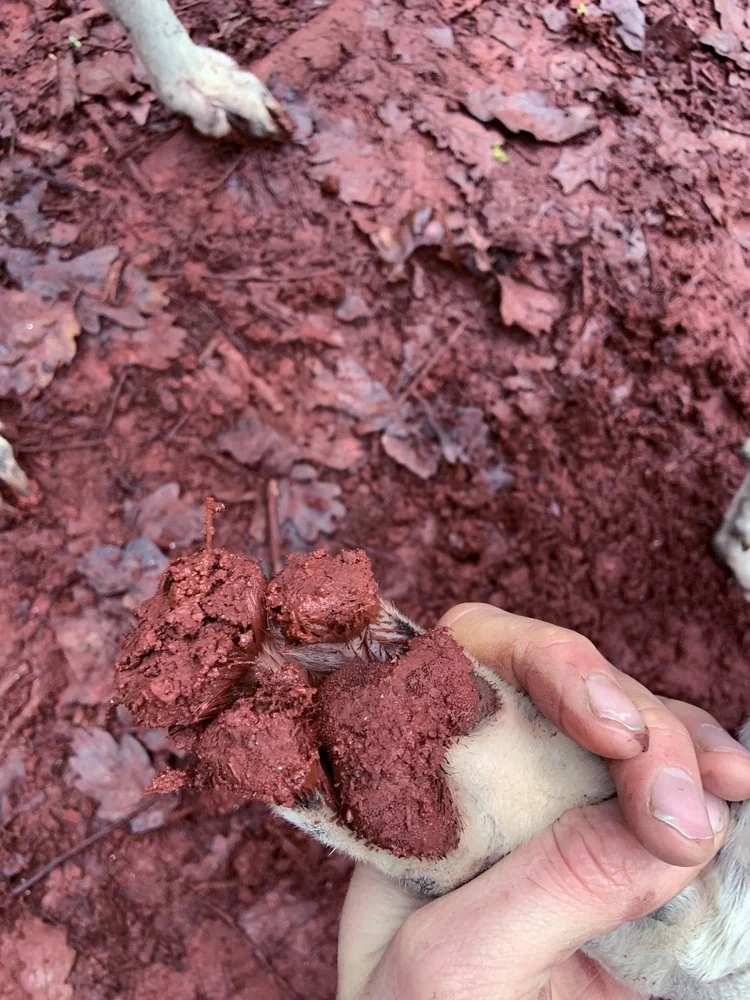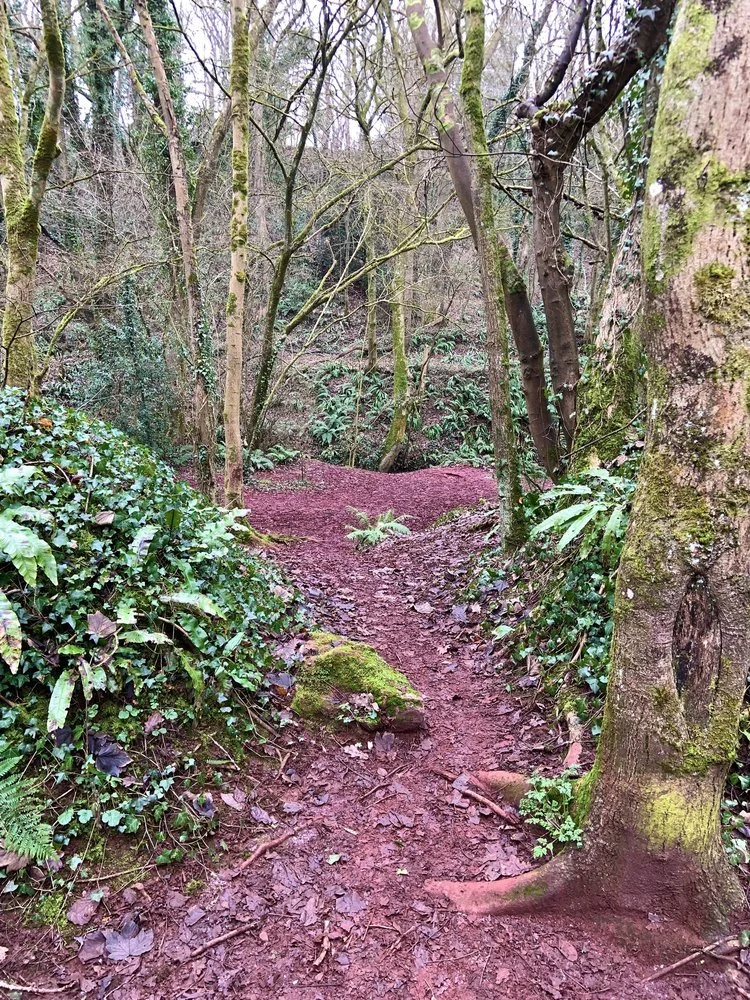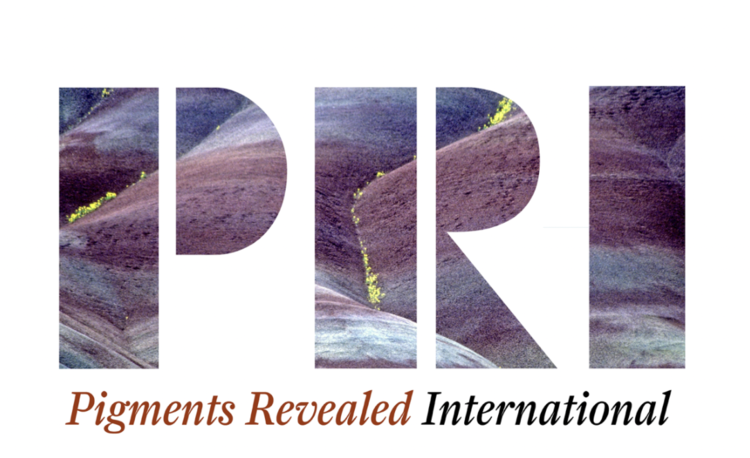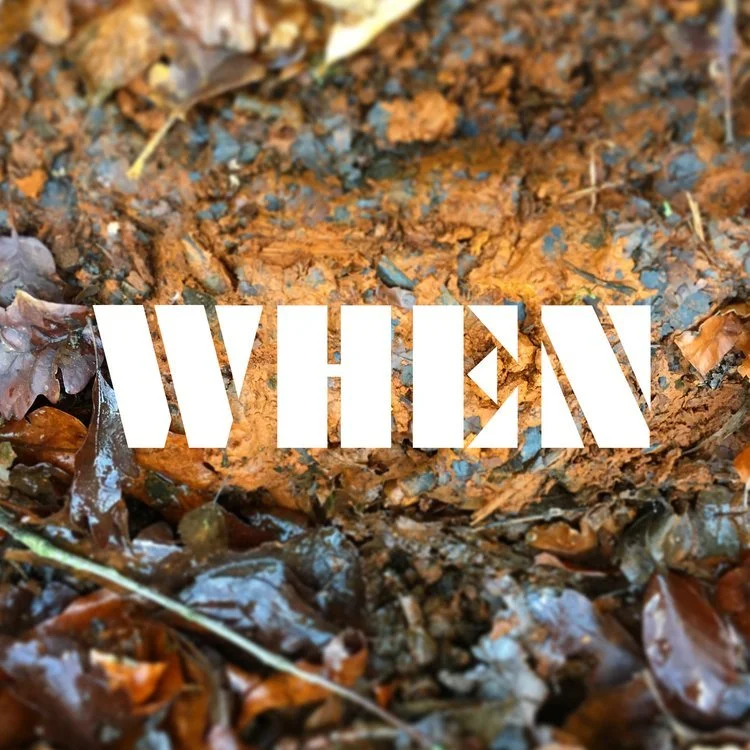pied midden: issue no.29 : bend down and dig : caroline ross & nick hunt
*scroll down to listen to an audio recording of Nick Hunt reading his story, ‘Spoils.’*
Otto’s foot with Spoils. Image courtesy of Caroline Ross.
other animals
As a child, the walls of my room were plastered with creased posters from from Ranger Rick and World magazines. Each issue came with a poster stapled to the middle, and I delightedly unfolded them and taped them to my wall as soon as they arrived, with one exception: pictures with humans didn’t make the cut. I didn’t want humans (I called them “people” back then) — those land-flattening, over-dressed beings who disrespected the rest of the planetary community so profoundly — to interrupt my gaze with their fleshy self-satisfaction. Yes, I was a child with vigorous opinions. I was so determined not to be identified as a human that I refused to be photographed unless I was in “rabbit pose,” my upper lip puffed up and my “paws” held at my chin with my hands bent down at the wrists.
My grandmother rolled her eyes when I insisted that other animals (I just called them “animals” back then) went to heaven too. She produced the same chuckle as she did when she assured me that when I grew up, contrary to my child convictions, I would joyously accept the name of my husband as my own. She was very much on the side of humans (especially the male ones). As a history teacher she saw the landscape as a backdrop for centuries of awe-inspiring human activity.
I wanted nothing to do with human histories. For me, outside places were a refuge from evidence of insensate human wrong-headedness. I didn’t know land histories, and I didn’t want to. To me, places without people were unstoried places. When I walked in the woods, I stepped outside the tedious arrow of time and existed in pure dialog with the wind and the rocks, the trees, in the present moment. The un(human)peopled posters of other animals in jungles, oceans and grasslands on my walls allowed me to imagine that there were places that existed outside human culture, where nothing human ever happened, and where there were no human stories to tell.
I thought I liked it that way, for years. When I first started to forage for wild pigments, as an adult, I liked that the only stories I knew that related to the pigments I found were personal. I wrote them on the little cards I stored in the jars that held my colored rocks and dusts: “Found with Tegra on the day we explored the far side of the dam, in light rain, next to a mushroom the same color as this pigment, early Spring, 2009” or, “On the road West, with Shaun and the dogs, snow and weak sun, 2012.” I deliberately left out the exact place names. The only important stories, and names, were my own.
That changed when I noticed that I was’t painting with the pigments I gathered, just storing them with their cards. Something was getting to me. There were stories, there, held in the stones, I just didn’t know them. I couldn’t pretend anymore. That was the beginning of Wild Pigment Project — an effort to learn the stories beyond my own, held in the land I gather.
Image courtesy of Caroline Ross.
a new pigment story
Our interview this month isn’t an interview — it’s a story. One made up by writer Nick Hunt, a writer who has gone on epic walks and written extensively about his adventures. Nick fell in love with a place near Bath, England, where the ground was a deep bright red, and told Pigment Person Caroline Ross all about it. She eventually travelled there with Nick to gather the pigment for this month’s Ground Bright. Nick didn’t plan to write a story, but out it flowed, with all the rhythmic quality of an ancient myth. When I heard it, I felt a longing for the pigments I gather to be woven in to a story like Nick’s, larger than myself, connected on one end to the materiality of the pigment, and on the other to a human community. I felt it as a physical ache, a longing.
I don’t story the pigments I work with in quite that way, even when I long to. As I discovered, eventually, the place where I forage does have stories that are connected to humans and many other animals, like this heroic tale about elder Esther Stutzman and a newly-published Kalapuyan dictionary that was in the news this week. Someday, when enough time has passed, I hope that a sprinkle of my essence can be part of an epic, enduring story. Maybe, a story about a dark time when some humans forgot that the other animals were people, and also forgot that some of the other people were humans…until the earth called them back. It’s a story about how ochres in every hue — purple and green, pink and orange, red and blue — sang to these lost people and invited them to press their ears against the ground and listen, and to gather small handfuls of colored dusts in their pockets and bask in their beauty. That told them to share these vibrant dusts with each other, and, through this sharing, to listen to each other, and through this listening, to learn to listen to all the other animals again.
Or something like that.
Nick Hunt and Otto near Bath, England. Image courtesy of Caroline Ross.
Back to the pigment described in Nick’s riveting tale: a brilliant deep red hematite called ‘Spoils,’ which is shot through with tiny sparkling mica flakes. It was found along the Boyd River which runs near Bath, at the now empty site of an abandoned ochre works where ochre was once made into paint for iron bridges and other industrial purposes. Nick came across this ochre while out walking his dog Otto, and noticed how striking the pigment looked against Otto’s monochrome fur. He took photos and sent them to three-time Ground Bright contributor Caroline, followed by a packet of pigment. One of the first things she did once pandemic restrictions were lifted was book a ticket on a train to visit this pigment with Nick and gather some for Ground Bright. She says, of this pigment, which she names ’Spoils,’: “the Spoils: the remains, that which is incomplete, what the victor takes, what is left, what will not last forever.”
She continues: “Once this valley was a center of polluting industrial processes, shipping colour internationally. Now it is an abandoned post-industrial wasteland, rather beautiful, full of wild bee hives, river walks, and crumbling hidden brick walls. Not a single part of England is pristine. Extraction as a method and goal was first mastered here, forced upon both land and people, before being exported worldwide at untold cost. This gorgeous, ragged, bloody, shining color is resplendent in ambiguity, paradox and saturation. Of all of the UK’s colors, it is the one closest to my heart.”
Caro is, as I write, at work on a book, to be published in 2023 by Search Press, called Foundandground’s Guide to Making Natural Paints. She’s generously included her detailed recipe for making watercolor paints in this month’s Ground Bright packet. If you’re not a subscriber, and you’d like to see it, go here. The recipe is included in a sample of a new all-digital WPP offering now open for subscription, called GROUND BRIGHT LIGHT. It’s a monthly digital goodie bag that includes everything that comes in the in-real-life GROUND BRIGHT subscription (the recipe, the pigment description, etc), minus the pigment but plusextra photos, invites (and more to be added as it grows.) Naw, you don’t hafta pay if you want to try it: use code BRIGHTLIGHT at checkout to get your first month free. And as an extra special bonus, anyone who signs up by April 11th will be entered into a drawing for a chance to have a real packet of Spoils shipped to them. There’s more than one so your chances are good. :)
You can also contact Caro herself at www.carolineross.co.uk, for anything more you’d like to know about her pigment or her book.
Ok, are you ready for the story? Read below. Or, if you’d like, sit back, close your eyes, and listen. That’s right — Nick did us the great favor of recording his mellifluous voice reading his fable for us. Press play below to listen.
Caroline Ross gathers Spoils. Image Courtesy of Caroline Ross.
spoils short story by nick hunt
The daughter of a woodcutter went foraging in the King’s Wood, down by the bubbling river where the green ferns grow. It was a frost-hard winter and her family had no food. Scrabbling in the earth for roots, she looked up to see a golden hind watching her through the trees, giving off a shine so bright she thought her eyes were wrong. She loved the animal on sight, but her father’s axe was in her hand and her family wanted food. So she struck the hind with her father’s axe. Its body split in two. Its blood poured out and soaked the ground, rivers and waterfalls of blood, and the girl wept for what she’d done. Her tears sparkled in its blood like multitudes of stars. Unable to move from grief, she lay down upon the ground. The frost-hard day went by, and the bitter frozen night. When she awoke the hind was gone, not a trace of its flesh remained. She saw that her arms were red, her hands were red, her face was red, her skin stained deeply with its blood, still sparkling with tears. She did not return to her father’s home because she was ashamed. And so she took to wandering, between the river and the sea. Villages were becoming towns, towns were becoming cities. Wherever she walked the land turned red, and people named places after her: Redland, Redfield, Redcliffe, Redmaids. But nowhere was the ground as red as that place where she killed the hind.
Years later, a man called Boyd went walking in the King’s Wood, down by the bubbling river where the green ferns grow. In a clearing in the wood he saw the deeply red-stained ground, giving off a shine so bright he thought his eyes were wrong. He scraped it with his fingernails. The mud sparkled with mica. Boyd was a poor man but he saw the earth was rich. And so he built a factory there and other men came to join him. The river was dammed and culverted. Brick buildings went up in the trees. There was dust and smoke and noise. Iron tracks ran by the river. The red earth of the Golden Valley was dug by shovel and machine, its colour stolen out of it, sold for inks and paints and dyes. Its redness seeped across the world to brighten other things. New hills rose in the King’s Wood, spoil heaps of rocks and slag. There were no more woodcutters. There were no more hinds.
Boyd was no longer young. He walked down by the river. The soil was drained, its power gone, dust-dry, just desiccated dirt. He stirred the dust with his boot. It no longer sparkled. Boyd smoked and walked. His work was done. The trees had mostly been cut down, eaten up by the machines. He turned to go, but as he did he saw a woman watching him, standing where the green ferns grow. Her skin gave off a shine so bright he thought his eyes were wrong. He almost couldn’t look at her but he had to look at her. He brought her from the King’s Wood and took her to his home. The woman stepped out of her white dress, out of her white skin, and everywhere she was red. Her teeth, her hair, her fingers. Her body sparkled like stars. I am rich, said Boyd. The earth is rich, the woman said. She took him in her red arms, into her red heart, and together they went into the earth. In the morning they were gone.
The buildings are collapsing now, half sunken, overgrown with vines. The iron tracks are rusted. Bricks crumble in the trees. Young oaks spread steeply up the slope. There is the song of many birds. A horse stands on a spoil heap which is now a nettled field. The River Boyd runs through the old King’s Wood in the Golden Valley, although there is no longer any king, and no more golden hinds. A tarmac path leads past the clearing where the green ferns grow. In the right light you can see it there, so bright you think your eyes are wrong: the deep red earth, the sparkling.
Bend down and dig a little.
revealing pigments revealed international
March 22 is not only World Pigment day: it’s the day that a brand new pigment-focused platform, called Pigments Revealed International, opens its doors for membership.
What is Pigments Revealed International, you ask? For those of you who haven’t yet caught the buzz: PRI is a 501c3 organization with a 10-person board of scientists, researchers, anthropologists, artists and academics, founded and directed by my good friend and colleague, Melonie Ancheta, herself an artist and pigment researcher. The organization was born from the Pigments Revealed Symposium 2021, also directed by Melonie, for which ochre expert Heidi Gustafson and I were co-organizers and major energetic and creative contributors. PRI’s projected vision is to support research and education which will explore the relevance of pigments in ‘understanding human stories’ and ‘the significance of pigments to human evolution,’ while fostering ‘a global cross-disciplinary pigment community.’ Think research grants, pigment education centers, and large-scale international collaborations….
I could not be more proud of Melonie Ancheta for the extreme amount of work and personal fire she’s put into getting PRI off the ground. Big congratulations Melonie and all the rest of the dream team! I was so honored to have been invited to join the PRI board but, after much thought, I decided to continue to make Wild Pigment Project my focus, while being an informal advisor to PRI (which has been so much fun, watching it all form and being able to share what I’ve learned through WPP…!).
There’s going to be lots of inaugural activity happening over at PRI in these next few months, so keep your eyes on them. And be sure to become a member on March 22.
How is WPP distinct from PRI, since they’re both community-centric pigment orgs? Melonie says she likes to think of them as “sisters, with different personalities, skills, and offerings.” I agree. Wild Pigment Project is a one-person vision, an organization founded, directed and run by me (with a lot of support from my partner, textile artist Noelle Guetti!). Its mission is to connect artists to the land through the inspiration of the beauty, presence and the complex cultural, geological and ecological histories of wild, foraged pigments. A major focus is community building and fostering diverse conversations about land, history and the foraging of materials for art-making. What does pigment foraging and use mean to people generationally harmed by settler colonizer violence, like land theft, cultural erasure and enslavement? What does it mean to people privileged by historical enslavement and land theft? And what does it mean to the earth, to the soils and the rocks themselves? Can wild pigments present opportunities for reciprocation with land? Asking questions and listening to complex answers has been, and continues to be central to WPP.
PRI opens for membership on March 22. Image courtesy of PRI.
Wild Pigment Project has been instrumental in building what we can now casually refer to as the “global pigment community.” It’s fun for me to think back to the days (waaay back in ’19!) when vigorous combing of the internet produced a small handful of contemporary artists working with foraged pigments. Since then, Wild Pigment Project has, through its nearly 40K instagram followers, 2K+ newsletter readers, 600 or so people who have at one time or another subscribed (or still do) to Ground Bright, 130 artists in the online exhibit, 60+ featured Pigment People practitioners/educators, and the countless other people the project has reached through interviews, lectures, courses and presentations — helped build an important mycelial network of interlaced relationships between artists all over the world. I’ve had the joy of coining a couple of now frequently-used terms (“wild pigments” and “pigment people”) and the fun of helping introduce pigment geniuses to each other. PRI will bring an even broader range of people, working in many fields of pigment research, into this community with us.
What does the future hold for Wild Pigment Project? More conversations, more collaborations, more education, and a lot more curation. The upcoming large group exhibition at form & concept gallery in Santa Fe, which will show artists’ work alongside their personal pigment materials, is the first gallery exhibit of its kind. And, Māori artist Sarah Hudson from Kauae Raro Research Collective and I are plotting a brand new, pigment-related, Land Back-focused initiative together that we can’t wait to launch this summer.
So: mark your calendars for March 22, when PRI accepts new members, for $22/year. Membership gives you access to all sorts of goodies including a massive, incredible data base of pigment research articles as well as an opportunity to join their Pigment Community Page and list your events and workshops. On the 22nd, they’ll be offering free presentations by five different pigment practitioners, including, yes, this month’s pigment contributor, Caroline Ross, who will speak about foraging and the translation of ancient materials into contemporary life. WPP Pigment People Catalina Christensen and Lucy Mayes will also take the stage, joined by ochre anthropologist Tammy Hodgskiss Reynard and ancient book conservator Kristine Rose-Beers. You’ll find a full description of the event, here.
Right, and, also on March 22 since it is World Pigment Day, as officially declared by Ruth Siddall and Jo Volley in 2020, the Slade School of Art in the UK will be offering free attendance to their Color & Poetry: A Symposium, March 20 -22. You won’t want to miss textile artist Lucille Junkere’s talk, Jamaican Indigo — Healing and Reconnection, on the 22nd at 2:30 GMT. A pigment-packed day, to be sure.
In dark times like these, when the world is tensed for new sorrows, wild pigments shine for us, through us, with us.
Stay Connected,
<3 Tilke
p.s. If you have any insights about important future directions you think Wild Pigment Project should take, or anything else you’d like to whisper in my ear, I’d love to hear you. Write to me at info@wildpigmentproject.org.
The beam that is Caroline Ross. Photo courtesy of Caroline Ross.
Image from Grounded Community, a jolly group of community gardeners in Boscombe, Bournemouth, Caro’s home town, who are receiving Ground Bright’s 22% donation this month. Photo from their website








